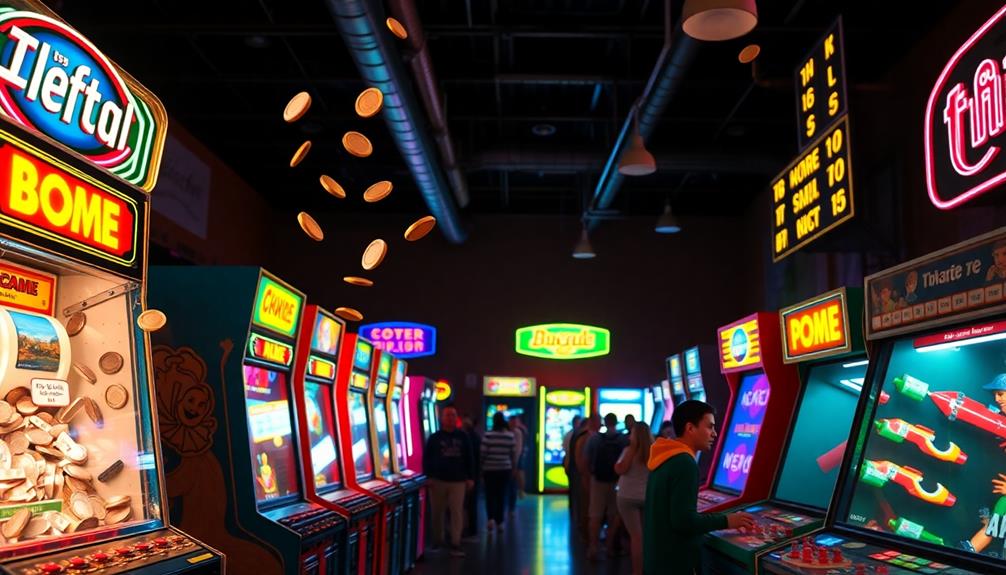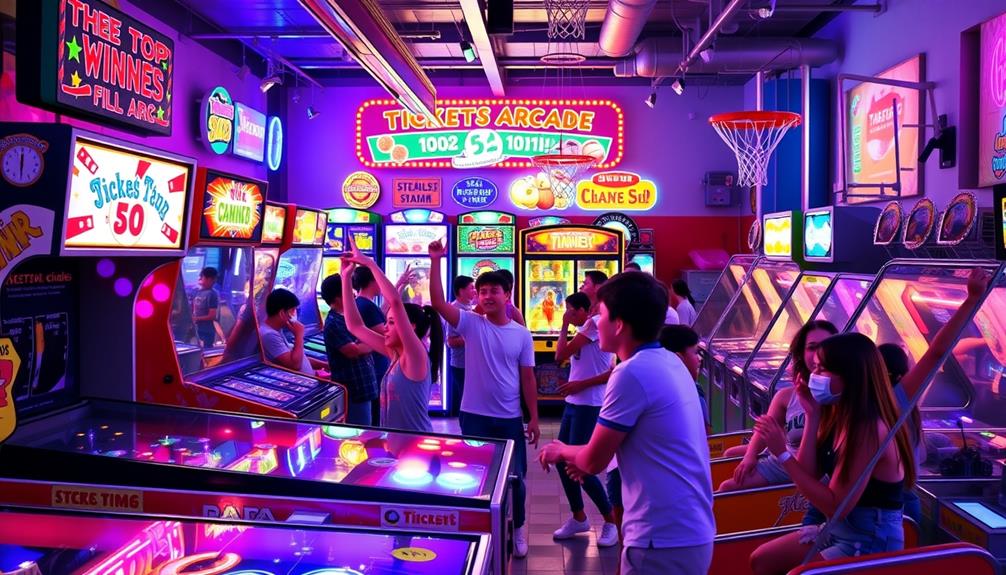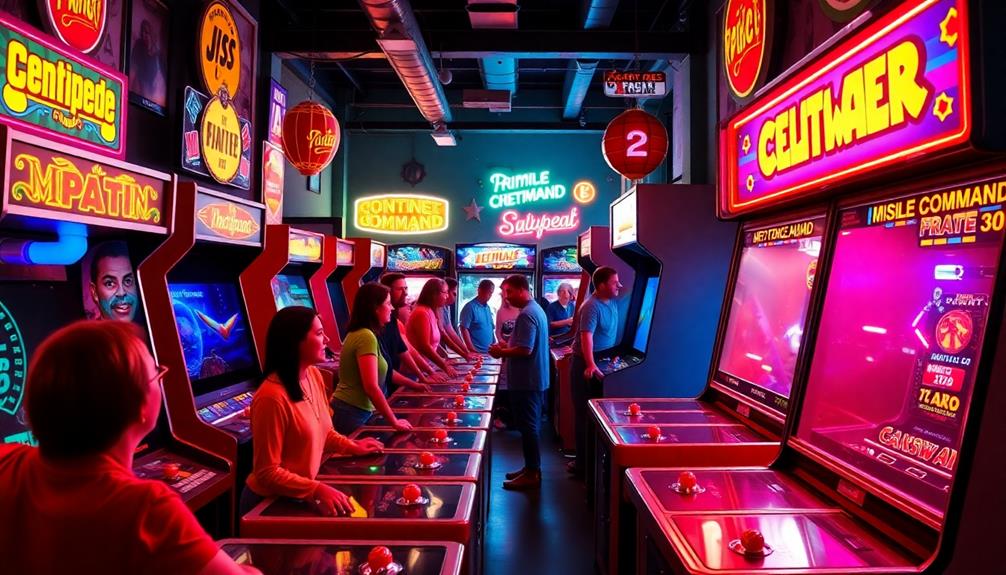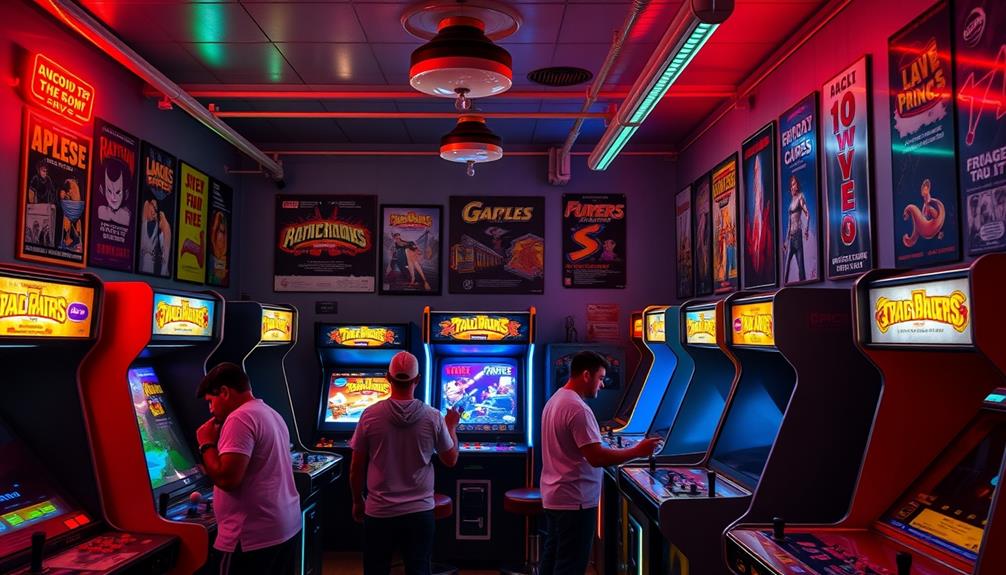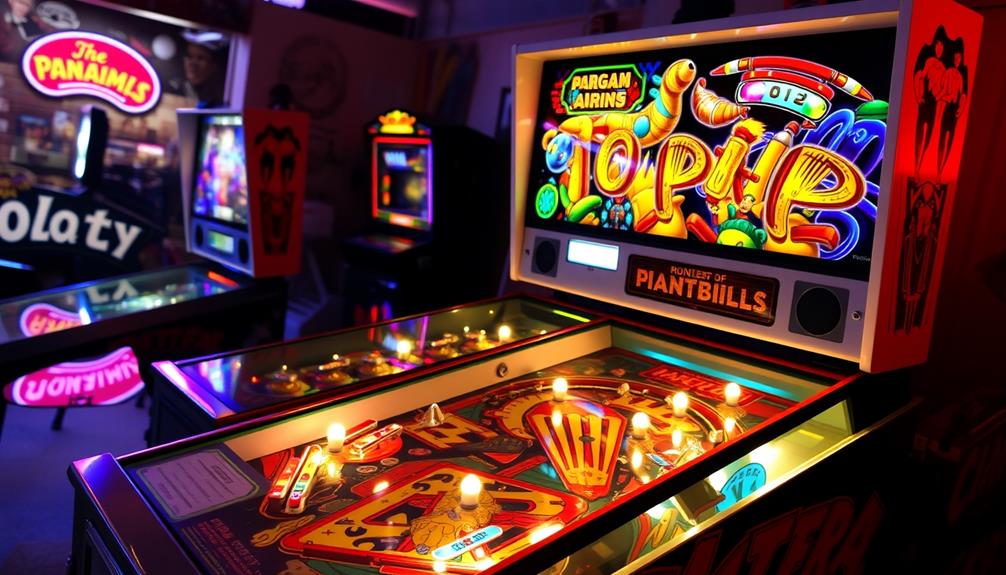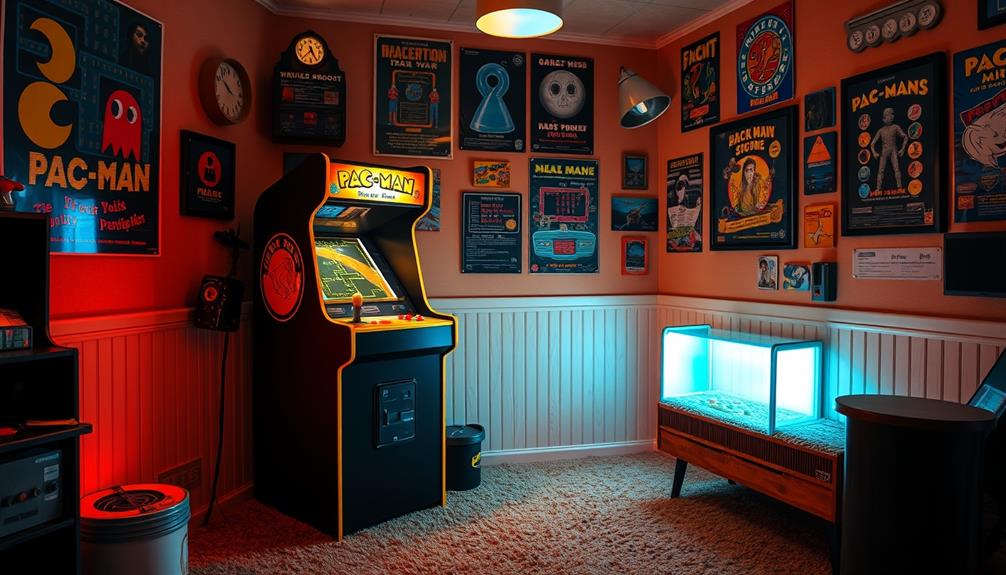Absolutely, **arcade games** have the potential to bring in money. The arcade industry is on the rise, with **revenues expected** to reach $3.2 billion in 2023. There are multiple avenues to generate income such as game plays, snack sales, and merchandise. **Weekly revenue** for arcades typically falls between $1,100 and $2,000. Your success hinges on factors like game selection and pricing strategies. Moreover, there are different business models available that offer opportunities to increase profits. By implementing effective operational techniques and strategic planning, you can draw in and keep customers coming back for more. Keep reading for valuable tips on how to enhance arcade profitability.
Key Takeaways
- The US arcade market is expected to grow at a CAGR of 8.2%, indicating potential profitability.
- Average weekly revenue for arcades can range from $1,100 to $2,000, contributing to overall earnings.
- Revenue streams include game plays, snack sales, merchandise sales, and ticket redemption, enhancing profitability.
- Effective game mix and pricing strategies are essential for maximizing earnings and minimizing costs.
- Modern technology and social experiences attract diverse audiences, fostering repeat business and increased revenue.
Arcade Industry Overview
As the arcade industry experiences a revival, you'll find that the US market is projected to grow at a compound annual growth rate (CAGR) of 8.2% from 2023 to 2028, potentially reaching an impressive revenue of $3.2 billion this year.
This resurgence is fueled by nostalgia and a demand for diverse entertainment options, appealing to both older and younger generations.
Luxury cruises offer a unique way to experience fun and leisure, similar to the engaging atmosphere of modern arcades.
To maximize profits, understanding the game mix is essential. Modern arcades are evolving to incorporate advanced technology and unique gaming experiences, attracting a wider audience.
Your operational costs will play a significant role in determining profitability, as they can vary based on location and efficiency. Average revenue for arcades ranges from $1,100 to $2,000 weekly, depending on these factors.
Industry experts advocate for investments in the arcade sector, highlighting its potential for economic rewards.
With projections suggesting a market potential of approximately $5.48 million by 2030, now's an ideal time to contemplate entering or expanding within this dynamic market.
Revenue Streams for Arcades
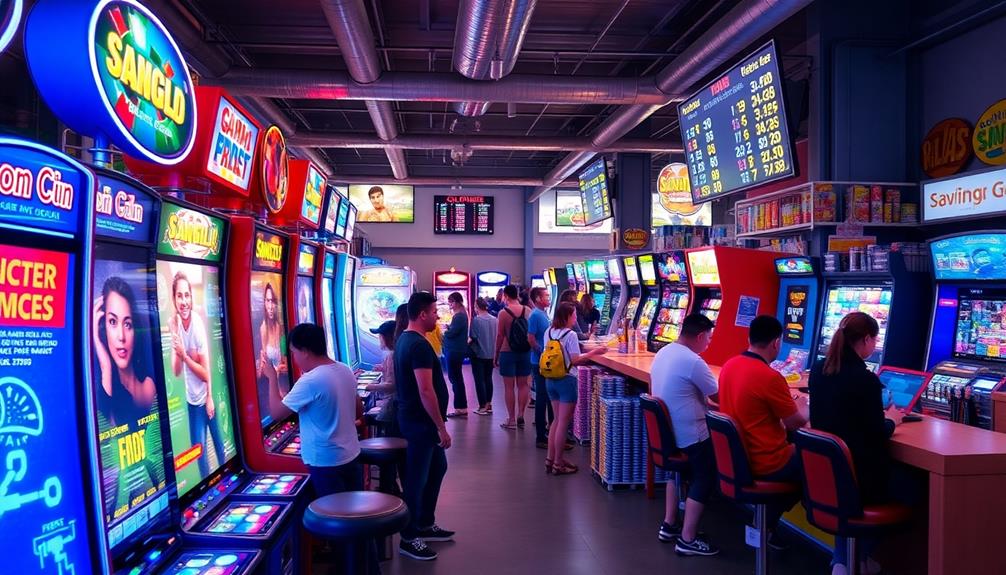
Understanding the various revenue streams available is key to maximizing your arcade's profitability. Your arcade can generate revenue through multiple channels, ensuring a robust financial foundation. Here's a breakdown:
| Revenue Stream | Average Cost per Item | Potential Revenue per Month |
|---|---|---|
| Game Plays | $0.25 – $2.00 | $5,000 – $40,000 |
| Snack & Drink Sales | $1.00 – $3.00 | Varies with foot traffic |
| Merchandise Sales | $5.00+ | Adds to overall revenue |
| Ticket Redemption Games | $0.50 – $2.00 | Encourages repeat business |
| Unlimited Gameplay Pass | $5.00 – $20.00 | Boosts average customer spending |
Focusing on redemption games can enhance the entertainment experience while encouraging repeat business. The average arcade game might bring in $200 to $485 weekly, depending on its condition and placement. By strategically managing these revenue streams, you can effectively increase your arcade's overall profitability. Aim to engage customers by providing a diverse mix of games and services, ensuring they have a memorable experience that keeps them coming back for more.
Factors Impacting Profitability

What drives the profitability of your arcade? The right game mix is essential, typically consisting of 60-70% redemption games, 20-30% video games, and 10-15% merchandisers or cranes. This balance enhances customer engagement and boosts revenue.
Additionally, incorporating popular best arcade machines can attract more players and increase foot traffic. You also need to focus on effective pricing strategies; with the cost of goods sold averaging around 15%, managing ticket output is important, as it usually falls between 25% to 35% on the dollar for redemption games.
Regular maintenance and quick repairs can't be overlooked. Game breakdowns can hit your profitability hard, so stocking commonly used parts will minimize downtime and keep your arcade running smoothly.
Remember, the average weekly revenue per game ranges from $200 to $485, and during peak hours, you could see up to $1,000 per game.
Making data-driven decisions in game selection is key. It's important to recognize that the most popular and profitable arcade games mightn't always align with what you enjoy personally.
Types of Arcade Business Models
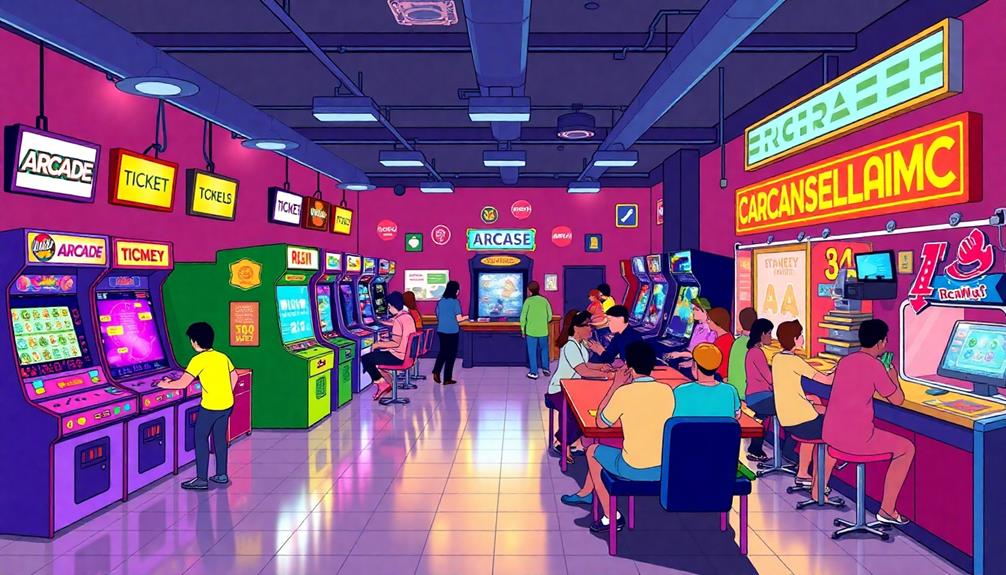
Arcade business models vary widely, each offering unique opportunities for profitability and customer engagement. For instance, incorporating interactive games can enhance the overall experience and draw in diverse crowds. Understanding these models can help you choose the right strategy for your arcade venture:
- Ownership Model: In this model, you select the games and retain 100% of the profits. It gives you control over game selection but requires upfront investment.
- Route Operators: This involves managing initial investments and maintenance, sharing revenue through equipment rotation. You'll need to build partnerships with locations but can expand your reach.
- Family Entertainment Centers (FECs): FECs combine arcade games with attractions like mini-golf and laser tag, appealing to families. This diverse offering enhances revenue potential, making it a lucrative business model.
- Redemption Arcades: Focusing on ticket redemption systems, these arcades target younger audiences. By offering engaging experiences, they encourage repeat visits and drive revenue through attractive prizes.
Each business model has distinct operational and financial implications. Your choice will influence profitability, customer engagement, and ultimately, the success of your arcade.
Operational Costs and Management
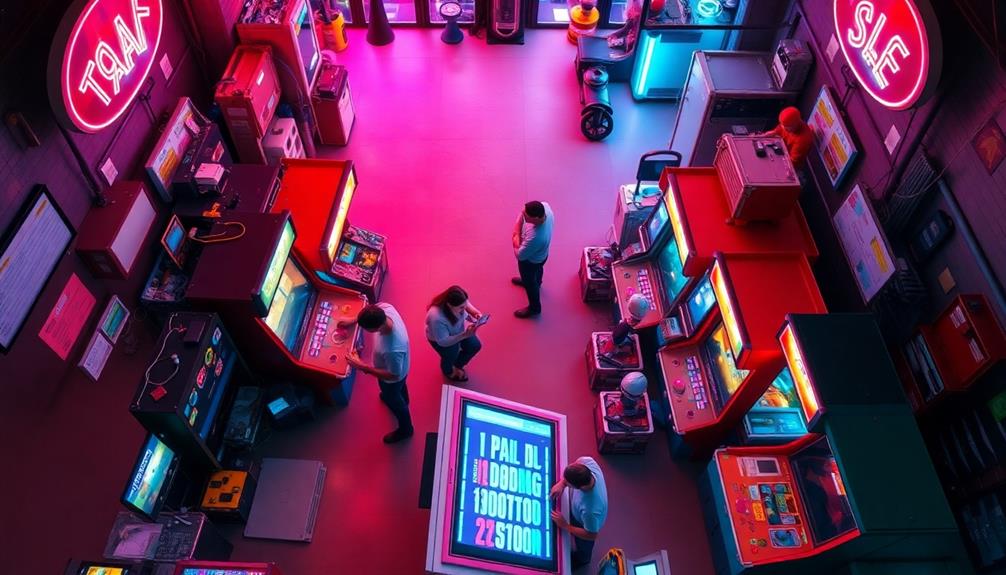
When running an arcade, you've got to keep a close eye on your key operational expenses.
Staffing and wages, along with maintenance and repair costs, can eat into your profits if you're not careful.
Just like crafting the perfect album, understanding these factors is essential for managing your expenses and ensuring your arcade thrives.
Consider the importance of a well-structured operational plan to create a seamless experience for your customers, akin to the flow of a good song thematic coherence.
Key Operational Expenses
Frequently, arcade owners face significant operational expenses that can make or break their business. Understanding these costs is essential for maintaining profitability. Here are four key operational expenses to take into account:
- Game Acquisition Costs: Investing in new games is important, but the costs can be hefty—averaging between $10,000 to $12,000 per game, and reaching up to $50,000 for high-end machines. It's necessary to select games that not only attract players but also have high replay value, similar to best rated pinball machines of 2024.
- Staff Wages: Though we won't dive deep just yet, managing personnel effectively is critical, as wages can greatly contribute to your operational costs.
- Maintenance and Repair Costs: Regular upkeep of your arcade games prevents breakdowns and minimizes downtime, especially during peak hours. Neglecting this can lead to lost revenue.
- Marketing Efforts: Attracting and retaining customers requires ongoing marketing efforts, which should be budgeted effectively to guarantee your arcade remains financially sustainable.
Location selection also plays an essential role in rent costs; a prime spot can drive foot traffic but may increase your fixed expenses.
Staffing and Wages
Managing staffing and wages is a significant aspect of operational costs that can directly influence an arcade's profitability. Employee salaries often account for 20% to 30% of total expenses, so it's vital to keep a close eye on staffing wages. The average wage for your front-line employees might range from $12 to $15 per hour, while management roles could exceed $40,000 annually.
To guarantee financial health, it's also important to take into account how these expenses fit within your overall budgeting plan.
To maximize profitability, maintaining a lean staffing model is essential, especially during off-peak hours with lower customer foot traffic. You can implement effective scheduling strategies, like hiring part-time staff during busy times and reducing hours when traffic decreases. This approach helps optimize wage expenditures without sacrificing service quality.
Additionally, investing in training staff in customer service and basic maintenance can lead to long-term savings by reducing repair costs and improving overall operational efficiency. By focusing on these areas, you'll not only manage your operational costs better but also enhance the customer experience, which can further boost your arcade's profitability.
Balancing staffing levels and wages with customer demand is key to a successful arcade operation.
Maintenance and Repair Costs
Maintaining your arcade's games is essential to avoid costly breakdowns that can eat into profits. Repair costs can quickly add up, impacting your overall profitability. By prioritizing maintenance, you can enhance operational efficiency and keep your games performing well.
Additionally, incorporating elements from family-friendly attractions can help draw in a more diverse crowd, increasing foot traffic and revenue. Here are some key strategies to take into account:
- Regular Inspections: Schedule routine checks on all machines to catch issues before they escalate, ensuring ideal game performance.
- Stock Common Parts: Keep a supply of frequently needed parts on hand to facilitate quick repairs during peak hours, minimizing downtime and maximizing revenue.
- Train Your Staff: Equip your employees with basic maintenance knowledge to handle minor repairs, reducing your reliance on external services and cutting repair costs.
- Assess Game Performance: Regularly evaluate earnings from each machine to identify underperformers. This allows you to trade out low-earning games, keeping your collection fresh and appealing, which boosts customer satisfaction.
Future Trends in Arcade Gaming

As you explore the future of arcade gaming, you'll notice technological advancements reshaping the landscape.
The integration of high-quality content and engaging experiences is essential for attracting and retaining players. Evolving game formats and the rise of social gaming experiences are making arcades more engaging than ever.
This shift not only attracts new players but also keeps seasoned gamers coming back for more.
Technological Advancements Impacting Arcades
The future of arcade gaming is being reshaped by cutting-edge technology, engaging a new generation of players.
Today's arcades are becoming more than just places to play; they're evolving into tech hubs that enhance your gaming experience. For instance, the integration of AI-powered virtual reality in e-learning is indicative of how immersive technologies can enhance engagement in gaming as well.
Here are four key advancements transforming the landscape:
- Virtual Reality Experiences: VR and AR are drawing in tech-savvy audiences, providing immersive environments that traditional games can't match.
- Cloud-Based Gaming Systems: These systems allow for remote access and game updates, making your gaming experience seamless and convenient.
- Data Analytics: Operators are leveraging data analytics to optimize game selections based on your preferences, ensuring that the most popular games are always available.
- Customer Engagement Strategies: Gamification elements like loyalty programs and interactive leaderboards encourage repeat visits, turning casual players into dedicated fans.
As mobile integration becomes more prevalent, using your smartphone for gameplay and rewards simplifies operations, making visits to the arcade even more enjoyable.
With these advancements, arcades aren't just keeping up; they're setting the stage for the future of gaming.
Evolving Game Formats
While traditional arcade games still hold a nostalgic charm, evolving game formats are redefining the arcade experience for today's players. The integration of virtual reality (VR) and augmented reality (AR) is becoming increasingly popular, creating immersive environments that captivate tech-savvy audiences. This highlights the importance of nurturing an imaginative mindset, as discussed in igniting creativity.
Furthermore, the rise of mobile and online gaming has pushed arcades to incorporate multiplayer and social gaming formats. This fosters a communal atmosphere that appeals to diverse age groups, making the arcade a go-to destination for social interactions.
Redemption game formats are also evolving, featuring innovative prize systems that allow you to win higher-value items. This not only boosts customer satisfaction but also encourages repeat visits, making these games highly profitable.
Arcade bars are blending classic and contemporary gaming experiences, effectively targeting nostalgia while creating a modern social environment. With advanced technology in game development, including skill-based games and leaderboard systems, arcades are attracting younger demographics.
This variety of games increases competition and engagement, driving overall profitability and ensuring arcades remain relevant in a rapidly changing entertainment landscape.
Social Gaming Experiences
How can modern arcades evolve to enhance social gaming experiences? To attract young adults and maximize potential revenue, arcades need to focus on creating an engaging atmosphere that promotes community interaction.
Here are four strategies:
- Themed Events: Organize regular themed nights or tournaments centered around popular games. This encourages repeat visits and fosters a sense of community among players.
- Integrated Technology: Incorporate advanced technologies like virtual reality and immersive gaming experiences. This appeals to tech-savvy audiences looking for entertainment venues that offer something beyond traditional game machines.
- Collaborative and Competitive Games: Offer games that encourage teamwork and competition, which can increase customer satisfaction. When players engage with each other, it enhances their overall experience and loyalty.
- Social Spaces: Design dedicated areas for socializing, such as lounges or bars, where players can relax and interact before or after playing. This encourages community engagement and makes the arcade a go-to destination for social gatherings.
Frequently Asked Questions
Is a Game Arcade Profitable?
If you manage an arcade well, it can be profitable. Focus on game selection, maintenance, and pricing to maximize earnings. Location matters, but with the right strategy, you can see significant returns on your investment.
By keeping popular and well-maintained games in your arcade, you can attract a steady stream of customers and increase your arcade game revenue. It’s also important to regularly inspect and repair machines to ensure they are in good working condition. By offering competitive pricing and promotions, you can also entice customers to spend more time and money at your arcade, further boosting your overall arcade game revenue. With a focus on these key areas, you can create a successful and profitable arcade business.
How Much Money Can an Arcade Make?
Imagine a bustling arcade, lights flashing and laughter echoing. You could see monthly earnings ranging from $5,000 in small towns to $40,000 in vibrant cities, depending on location, game variety, and management efficiency.
What Arcade Games Made the Most Money?
You'll find that games like claw machines, racing simulators, and popular redemption games consistently generate high revenue. By analyzing player preferences and strategic placements, you can maximize earnings from your arcade game selection effectively.
What Is the Annual Revenue of Arcade Games?
You'll find that arcade games generate a substantial annual revenue, often exceeding $3.2 billion in the US alone. Your location and game choices can greatly influence your slice of that lucrative pie.
Conclusion
In the ever-evolving arcade industry, you'll find that success hinges on innovation, engagement, and adaptability. By embracing diverse revenue streams, managing costs effectively, and staying attuned to trends, you can transform your arcade into a thriving hub of entertainment. Remember, it's not just about the games you offer; it's about the experiences you create. So, as you navigate this dynamic landscape, focus on connection, creativity, and community to guarantee your arcade not only survives but thrives.
